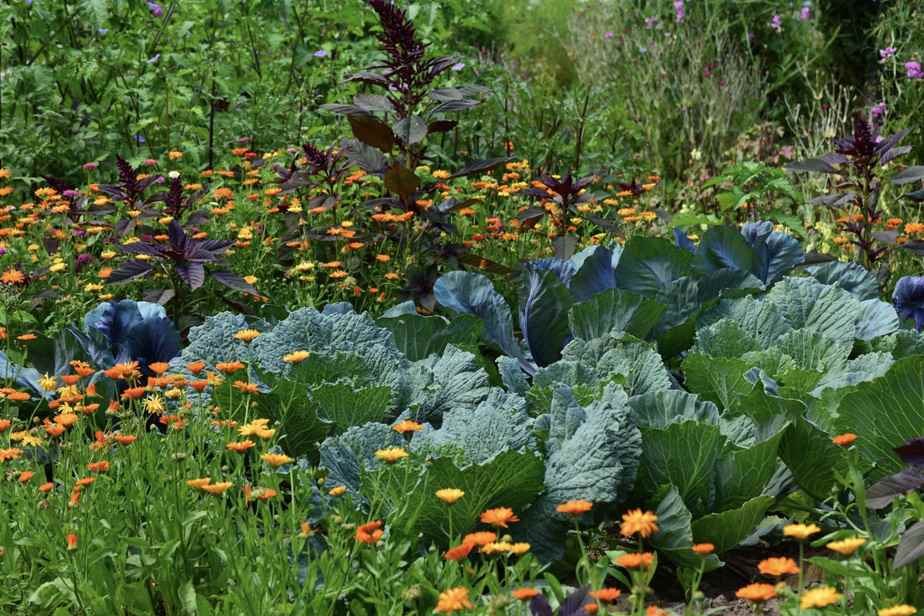The idea of using food plants for their ornamental value has been gaining ground for a few years. Edible landscaping (or foodscaping) invites itself in flowerbeds, in front of buildings, in streets or alleys. Make way for gourmet amenities!
Posted at 12:00 p.m.
Why plant vegetables outside the vegetable garden?
When you have a space favorable to the garden, bringing together edible plants in the same place and within easy reach is certainly easier for harvesting and maintenance. However, as long as it gets the right conditions for its development, a vegetable plant will grow anywhere, in a classic flower bed like a sidewalk overhang.
But vegetable plants are unattractive!
It is true that some look less good after harvest, but many retain attractive foliage throughout the season. Take kale, red cabbage, Swiss chard, Aztec spinach, chives and other herbs.
Yes, but we like flowers…
U.S. too ! Several add value to the plate: begonias, nasturtiums, daisies, daylilies, marigolds and agastache, to name a few. But many vegetable plants, especially beans and squash, have a pretty bloom that is followed by their fruit. As for purple broccoli, red cabbage and orange cauliflower, they easily eclipse many flowers with their generous and colorful fruits.
And cleanliness?
Nothing that a good soak in vinegar water can’t overcome! If the soil is of poor quality, you can always raise the level of the ground by adding a layer of healthy potting soil or place the plants in raised containers.
The idea of integrating vegetables, fine herbs, edible flowers, fruit trees and shrubs where space permits — at the end of an alley or in front of houses — is no longer an absurd idea. In the absence of land to invest, there is always a way to find a small plot of land to transform into a nurturing space, demonstrates the horticulturist and biologist Albert Mondor in Gourmet flowerbeds, in which he offers 100% edible arrangements, both aesthetic and gourmet.
Dress up an existing layout
Growing them in a container is an easy way to incorporate them into a classic layout without having to move what is in place, points out Albert Mondor. Leafy vegetables and herbs lend themselves particularly well to growing in pots. You can also replace annual flowers with “productive” plants, annual or perennial, and plant small fruit shrubs such as haskap, blueberry, blackcurrant or currant. Most fruit trees and large shrubs lend themselves to growing on the front of a house. The apple and plum trees, however, will require more care. To avoid the disappointment that accompanies their maintenance, bet instead on hardy fruit trees.
-

Photo David Boily, LA PRESSE archives
When ripe, sea buckthorn berries turn a dashing orange.
-

photo Wikimedia Commons
The white serviceberry flower is replaced by a dark blue berry that looks like a cornflower.
-

photo pixabay
Black aronia adapts to different soils and grows well in sun or light shade.
-

photo Wikimedia Commons
The Canadian elderberry produces small black fruits that lend themselves to jams and syrups.
1/4
Green the alley
Greening in the backyard is a way for those who don’t have access to a piece of garden to get their hands dirty. Make it a nurturing space, a friendly and unifying gesture around two key topics: food and gardening.
A tomato plant will adapt to the alley with enough sunlight and good soil. In this context, however, it is easier to opt for plants that require less maintenance and that resist pollution, underlines Marie-Andrée Asselin, from Urbainculteurs. The alley offers, among other things, perfect conditions for growing specimens that are too invasive in a small yard, such as mint, raspberry and daylily. “If you want to green a space inexpensively, these are good options,” notes the horticulturist who digs up the suckers from her raspberry bushes to plant them further away. Daylilies divide endlessly. Little by little, I am greening my alley! »
Edible screens and blankets
To hide a less aesthetic wall, to make a privacy screen, to wrap an arbor or to garden vertically, the choice is not lacking among edible climbers. Lebanese beans and cucumbers in particular provide shelter out of sight, as do grapevines, hops and arctic kiwis.
Climbing fruit trees
-

photo Patrice Laroche, Le Soleil archives
Hop
-

photo Wikimedia Commons
arctic kiwi
-

photo pixabay
grape vine
1/3
Among perennials, arctic kiwi and grape vine climb up to five meters. The first, in addition to its decorative green foliage variegated with white and pink, produces small fruits that you will only eat, says Marie-Andrée Asselin. Both will take a few years to bear fruit. For a faster result and a taste adventure, opt for hops, which can reach six meters in a year and produce fragrant inflorescences.
Taking to the streets
The majority of vegetable plants will have difficulty growing in the green squares that surround the trees in town. Shade and the root system under a mature tree are major obstacles. Forget the idea of growing carrots and other root vegetables or plants that need water and light.
By adding compost and a little soil if necessary, however, you can grow tasty ground covers such as Canadian asylum, fragrant bedstraw and large rhizome geranium, suggests Albert Mondor. Under a young tree are added other options such as mint, parsley, lemon balm, alpine strawberry, Swiss chard and spinach.

photo Wikimedia Commons
The white serviceberry flower is replaced by a dark blue berry that looks like a cornflower.

